Brand Management Strategies: A Report on Lidl's Practices
VerifiedAdded on 2022/12/28
|15
|4788
|22
Report
AI Summary
This report provides a comprehensive analysis of Lidl's brand management strategies. It begins with an introduction to brand management and its importance, followed by an in-depth examination of how Lidl builds and manages its brand over time, including strategies for brand recognition, sales enhancement, and customer loyalty. The report further explores brand portfolio and hierarchy management, including brand equity. It evaluates how brands are managed collaboratively and in partnership, both domestically and globally. Finally, it assesses different techniques for measuring and managing brand value. The report highlights Lidl's practices, challenges, and successes in the competitive retail market, providing valuable insights into effective brand management.
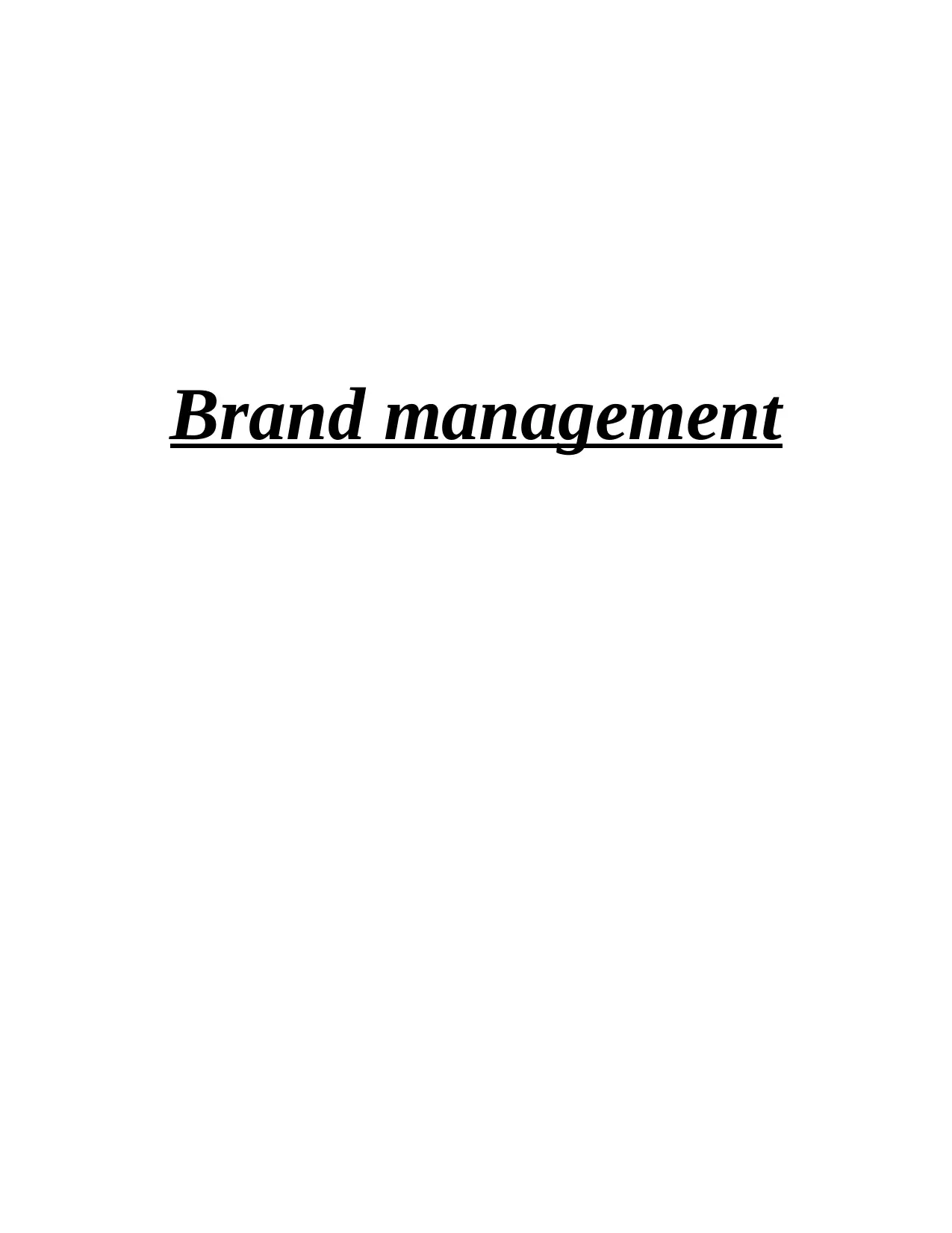
Brand management
Paraphrase This Document
Need a fresh take? Get an instant paraphrase of this document with our AI Paraphraser
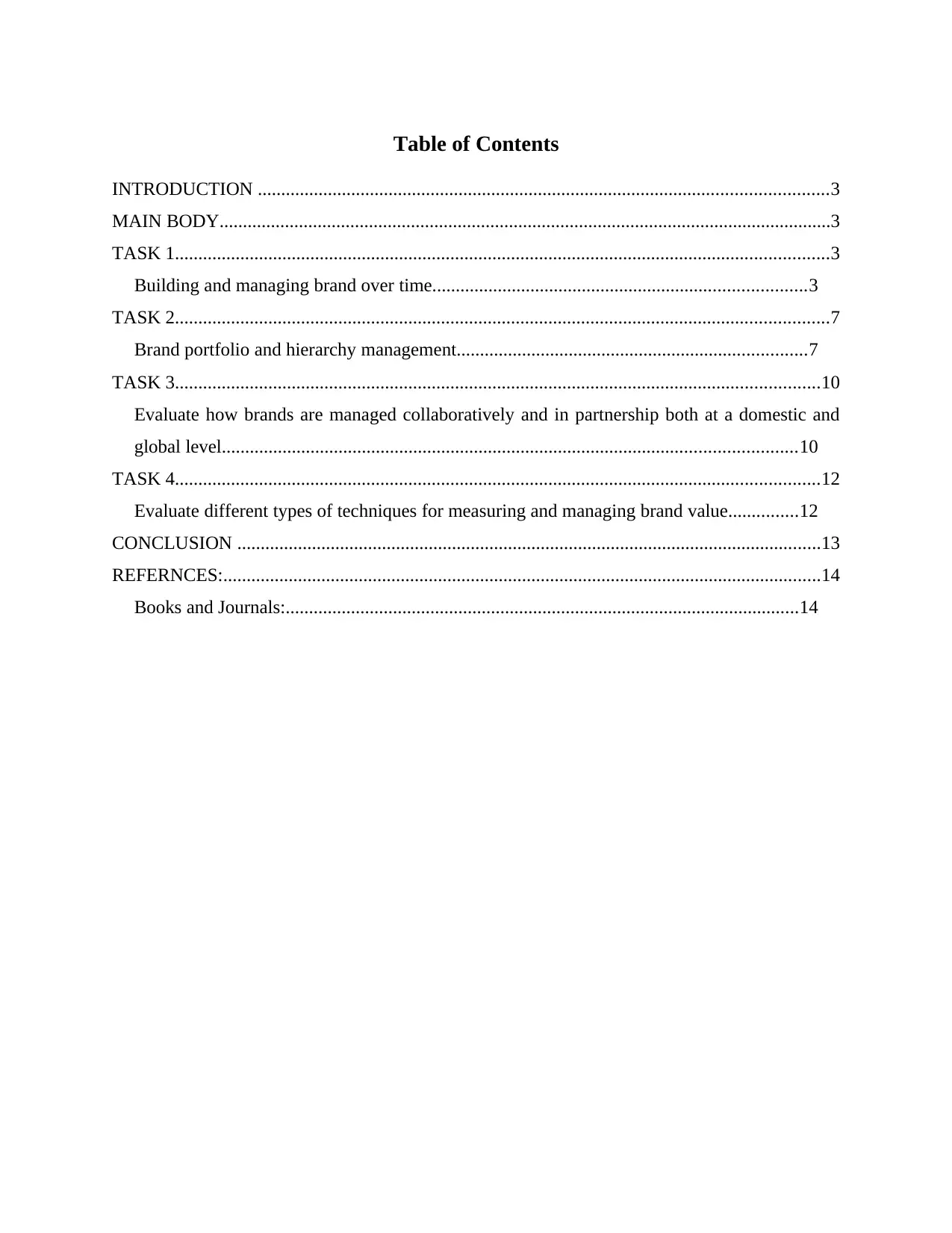
Table of Contents
INTRODUCTION ..........................................................................................................................3
MAIN BODY...................................................................................................................................3
TASK 1............................................................................................................................................3
Building and managing brand over time................................................................................3
TASK 2............................................................................................................................................7
Brand portfolio and hierarchy management...........................................................................7
TASK 3..........................................................................................................................................10
Evaluate how brands are managed collaboratively and in partnership both at a domestic and
global level...........................................................................................................................10
TASK 4..........................................................................................................................................12
Evaluate different types of techniques for measuring and managing brand value...............12
CONCLUSION .............................................................................................................................13
REFERNCES:................................................................................................................................14
Books and Journals:..............................................................................................................14
INTRODUCTION ..........................................................................................................................3
MAIN BODY...................................................................................................................................3
TASK 1............................................................................................................................................3
Building and managing brand over time................................................................................3
TASK 2............................................................................................................................................7
Brand portfolio and hierarchy management...........................................................................7
TASK 3..........................................................................................................................................10
Evaluate how brands are managed collaboratively and in partnership both at a domestic and
global level...........................................................................................................................10
TASK 4..........................................................................................................................................12
Evaluate different types of techniques for measuring and managing brand value...............12
CONCLUSION .............................................................................................................................13
REFERNCES:................................................................................................................................14
Books and Journals:..............................................................................................................14
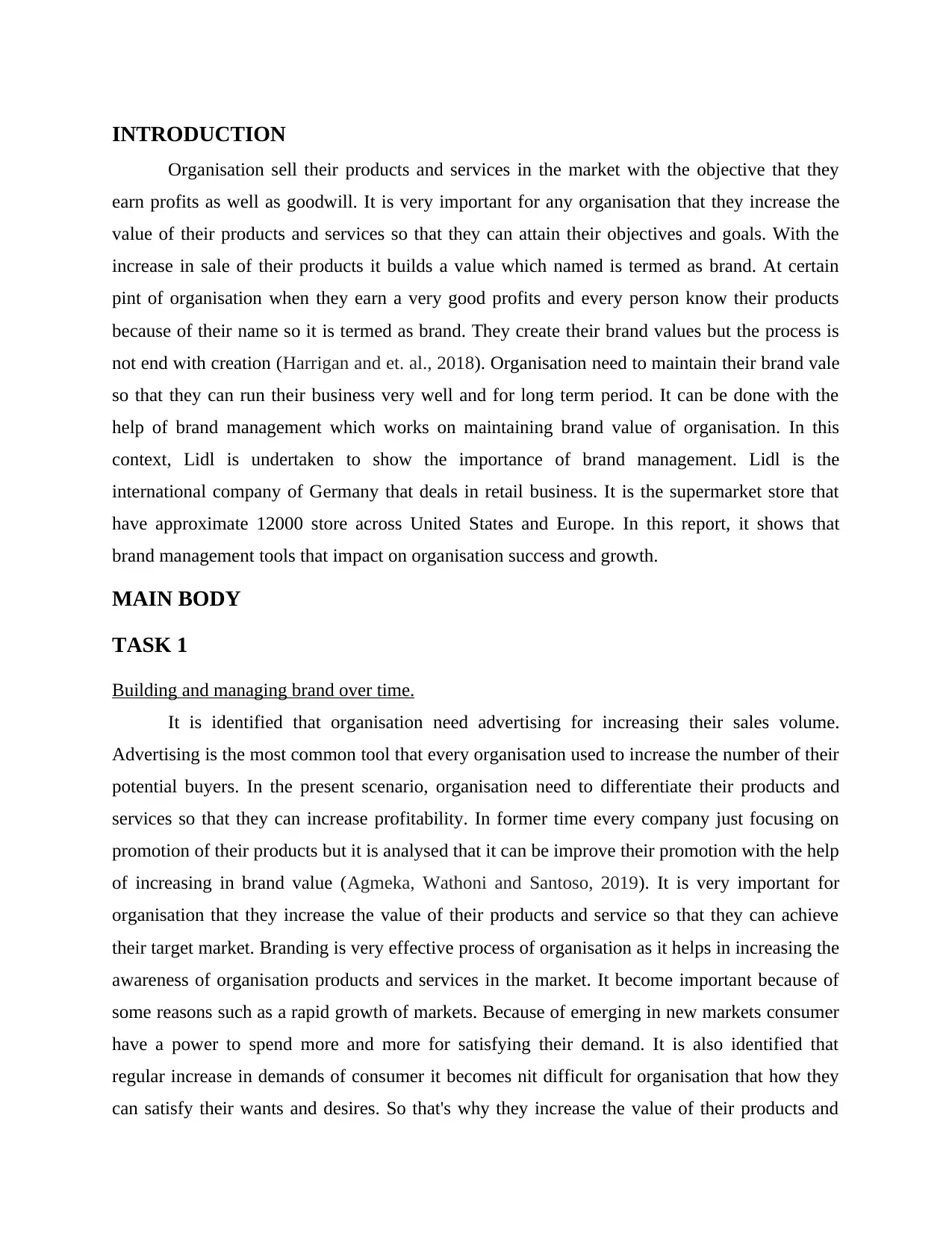
INTRODUCTION
Organisation sell their products and services in the market with the objective that they
earn profits as well as goodwill. It is very important for any organisation that they increase the
value of their products and services so that they can attain their objectives and goals. With the
increase in sale of their products it builds a value which named is termed as brand. At certain
pint of organisation when they earn a very good profits and every person know their products
because of their name so it is termed as brand. They create their brand values but the process is
not end with creation (Harrigan and et. al., 2018). Organisation need to maintain their brand vale
so that they can run their business very well and for long term period. It can be done with the
help of brand management which works on maintaining brand value of organisation. In this
context, Lidl is undertaken to show the importance of brand management. Lidl is the
international company of Germany that deals in retail business. It is the supermarket store that
have approximate 12000 store across United States and Europe. In this report, it shows that
brand management tools that impact on organisation success and growth.
MAIN BODY
TASK 1
Building and managing brand over time.
It is identified that organisation need advertising for increasing their sales volume.
Advertising is the most common tool that every organisation used to increase the number of their
potential buyers. In the present scenario, organisation need to differentiate their products and
services so that they can increase profitability. In former time every company just focusing on
promotion of their products but it is analysed that it can be improve their promotion with the help
of increasing in brand value (Agmeka, Wathoni and Santoso, 2019). It is very important for
organisation that they increase the value of their products and service so that they can achieve
their target market. Branding is very effective process of organisation as it helps in increasing the
awareness of organisation products and services in the market. It become important because of
some reasons such as a rapid growth of markets. Because of emerging in new markets consumer
have a power to spend more and more for satisfying their demand. It is also identified that
regular increase in demands of consumer it becomes nit difficult for organisation that how they
can satisfy their wants and desires. So that's why they increase the value of their products and
Organisation sell their products and services in the market with the objective that they
earn profits as well as goodwill. It is very important for any organisation that they increase the
value of their products and services so that they can attain their objectives and goals. With the
increase in sale of their products it builds a value which named is termed as brand. At certain
pint of organisation when they earn a very good profits and every person know their products
because of their name so it is termed as brand. They create their brand values but the process is
not end with creation (Harrigan and et. al., 2018). Organisation need to maintain their brand vale
so that they can run their business very well and for long term period. It can be done with the
help of brand management which works on maintaining brand value of organisation. In this
context, Lidl is undertaken to show the importance of brand management. Lidl is the
international company of Germany that deals in retail business. It is the supermarket store that
have approximate 12000 store across United States and Europe. In this report, it shows that
brand management tools that impact on organisation success and growth.
MAIN BODY
TASK 1
Building and managing brand over time.
It is identified that organisation need advertising for increasing their sales volume.
Advertising is the most common tool that every organisation used to increase the number of their
potential buyers. In the present scenario, organisation need to differentiate their products and
services so that they can increase profitability. In former time every company just focusing on
promotion of their products but it is analysed that it can be improve their promotion with the help
of increasing in brand value (Agmeka, Wathoni and Santoso, 2019). It is very important for
organisation that they increase the value of their products and service so that they can achieve
their target market. Branding is very effective process of organisation as it helps in increasing the
awareness of organisation products and services in the market. It become important because of
some reasons such as a rapid growth of markets. Because of emerging in new markets consumer
have a power to spend more and more for satisfying their demand. It is also identified that
regular increase in demands of consumer it becomes nit difficult for organisation that how they
can satisfy their wants and desires. So that's why they increase the value of their products and
⊘ This is a preview!⊘
Do you want full access?
Subscribe today to unlock all pages.

Trusted by 1+ million students worldwide
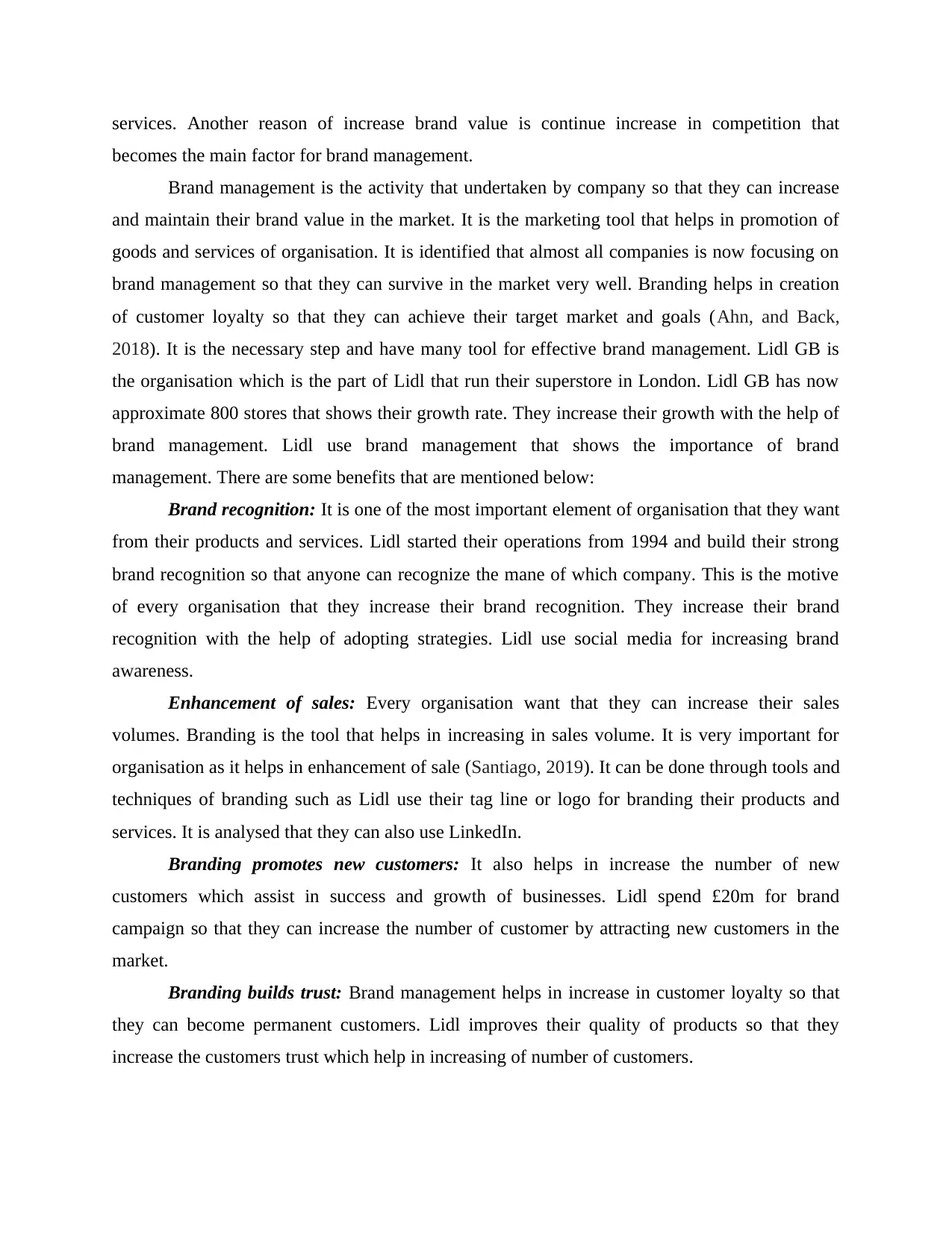
services. Another reason of increase brand value is continue increase in competition that
becomes the main factor for brand management.
Brand management is the activity that undertaken by company so that they can increase
and maintain their brand value in the market. It is the marketing tool that helps in promotion of
goods and services of organisation. It is identified that almost all companies is now focusing on
brand management so that they can survive in the market very well. Branding helps in creation
of customer loyalty so that they can achieve their target market and goals (Ahn, and Back,
2018). It is the necessary step and have many tool for effective brand management. Lidl GB is
the organisation which is the part of Lidl that run their superstore in London. Lidl GB has now
approximate 800 stores that shows their growth rate. They increase their growth with the help of
brand management. Lidl use brand management that shows the importance of brand
management. There are some benefits that are mentioned below:
Brand recognition: It is one of the most important element of organisation that they want
from their products and services. Lidl started their operations from 1994 and build their strong
brand recognition so that anyone can recognize the mane of which company. This is the motive
of every organisation that they increase their brand recognition. They increase their brand
recognition with the help of adopting strategies. Lidl use social media for increasing brand
awareness.
Enhancement of sales: Every organisation want that they can increase their sales
volumes. Branding is the tool that helps in increasing in sales volume. It is very important for
organisation as it helps in enhancement of sale (Santiago, 2019). It can be done through tools and
techniques of branding such as Lidl use their tag line or logo for branding their products and
services. It is analysed that they can also use LinkedIn.
Branding promotes new customers: It also helps in increase the number of new
customers which assist in success and growth of businesses. Lidl spend £20m for brand
campaign so that they can increase the number of customer by attracting new customers in the
market.
Branding builds trust: Brand management helps in increase in customer loyalty so that
they can become permanent customers. Lidl improves their quality of products so that they
increase the customers trust which help in increasing of number of customers.
becomes the main factor for brand management.
Brand management is the activity that undertaken by company so that they can increase
and maintain their brand value in the market. It is the marketing tool that helps in promotion of
goods and services of organisation. It is identified that almost all companies is now focusing on
brand management so that they can survive in the market very well. Branding helps in creation
of customer loyalty so that they can achieve their target market and goals (Ahn, and Back,
2018). It is the necessary step and have many tool for effective brand management. Lidl GB is
the organisation which is the part of Lidl that run their superstore in London. Lidl GB has now
approximate 800 stores that shows their growth rate. They increase their growth with the help of
brand management. Lidl use brand management that shows the importance of brand
management. There are some benefits that are mentioned below:
Brand recognition: It is one of the most important element of organisation that they want
from their products and services. Lidl started their operations from 1994 and build their strong
brand recognition so that anyone can recognize the mane of which company. This is the motive
of every organisation that they increase their brand recognition. They increase their brand
recognition with the help of adopting strategies. Lidl use social media for increasing brand
awareness.
Enhancement of sales: Every organisation want that they can increase their sales
volumes. Branding is the tool that helps in increasing in sales volume. It is very important for
organisation as it helps in enhancement of sale (Santiago, 2019). It can be done through tools and
techniques of branding such as Lidl use their tag line or logo for branding their products and
services. It is analysed that they can also use LinkedIn.
Branding promotes new customers: It also helps in increase the number of new
customers which assist in success and growth of businesses. Lidl spend £20m for brand
campaign so that they can increase the number of customer by attracting new customers in the
market.
Branding builds trust: Brand management helps in increase in customer loyalty so that
they can become permanent customers. Lidl improves their quality of products so that they
increase the customers trust which help in increasing of number of customers.
Paraphrase This Document
Need a fresh take? Get an instant paraphrase of this document with our AI Paraphraser
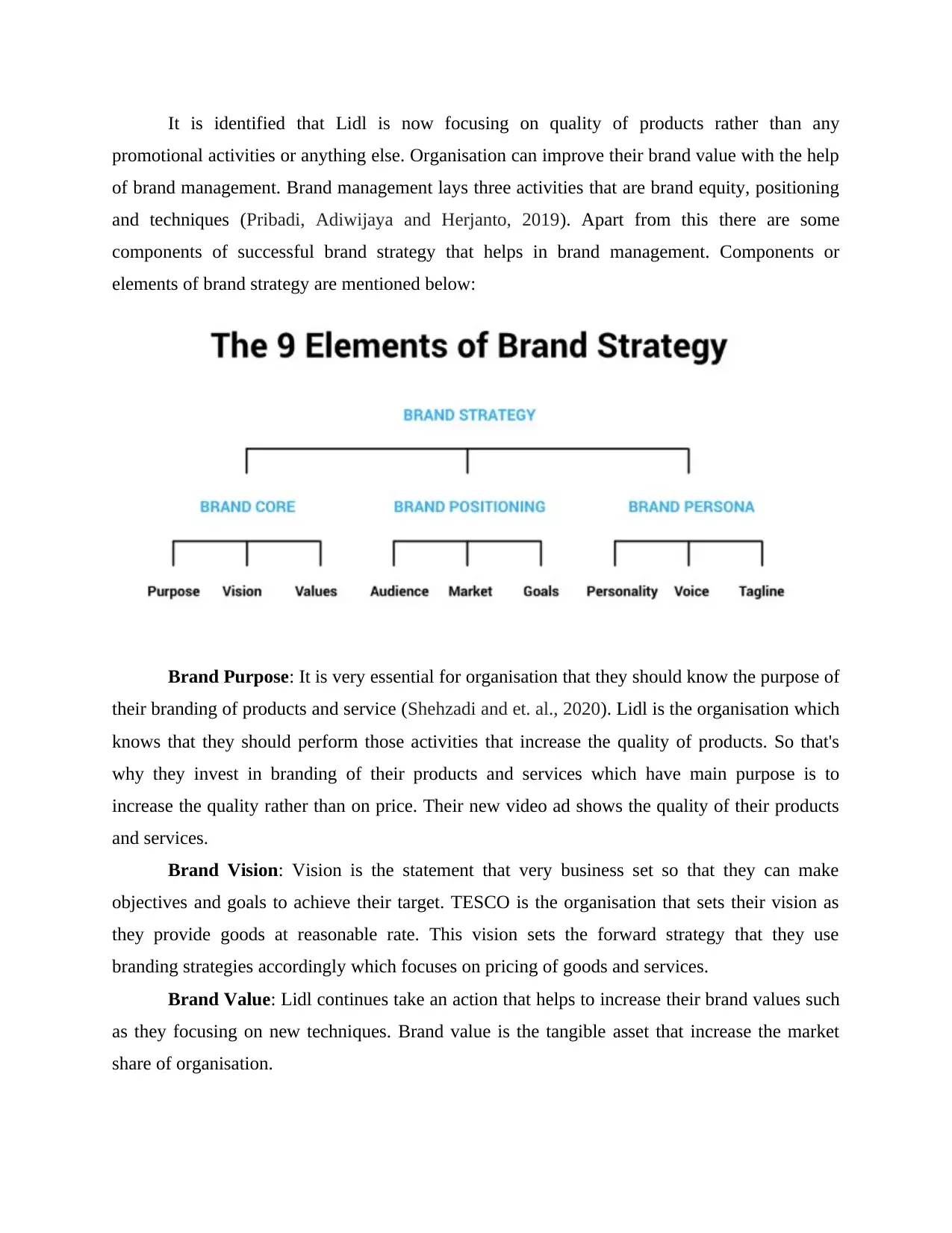
It is identified that Lidl is now focusing on quality of products rather than any
promotional activities or anything else. Organisation can improve their brand value with the help
of brand management. Brand management lays three activities that are brand equity, positioning
and techniques (Pribadi, Adiwijaya and Herjanto, 2019). Apart from this there are some
components of successful brand strategy that helps in brand management. Components or
elements of brand strategy are mentioned below:
Brand Purpose: It is very essential for organisation that they should know the purpose of
their branding of products and service (Shehzadi and et. al., 2020). Lidl is the organisation which
knows that they should perform those activities that increase the quality of products. So that's
why they invest in branding of their products and services which have main purpose is to
increase the quality rather than on price. Their new video ad shows the quality of their products
and services.
Brand Vision: Vision is the statement that very business set so that they can make
objectives and goals to achieve their target. TESCO is the organisation that sets their vision as
they provide goods at reasonable rate. This vision sets the forward strategy that they use
branding strategies accordingly which focuses on pricing of goods and services.
Brand Value: Lidl continues take an action that helps to increase their brand values such
as they focusing on new techniques. Brand value is the tangible asset that increase the market
share of organisation.
promotional activities or anything else. Organisation can improve their brand value with the help
of brand management. Brand management lays three activities that are brand equity, positioning
and techniques (Pribadi, Adiwijaya and Herjanto, 2019). Apart from this there are some
components of successful brand strategy that helps in brand management. Components or
elements of brand strategy are mentioned below:
Brand Purpose: It is very essential for organisation that they should know the purpose of
their branding of products and service (Shehzadi and et. al., 2020). Lidl is the organisation which
knows that they should perform those activities that increase the quality of products. So that's
why they invest in branding of their products and services which have main purpose is to
increase the quality rather than on price. Their new video ad shows the quality of their products
and services.
Brand Vision: Vision is the statement that very business set so that they can make
objectives and goals to achieve their target. TESCO is the organisation that sets their vision as
they provide goods at reasonable rate. This vision sets the forward strategy that they use
branding strategies accordingly which focuses on pricing of goods and services.
Brand Value: Lidl continues take an action that helps to increase their brand values such
as they focusing on new techniques. Brand value is the tangible asset that increase the market
share of organisation.
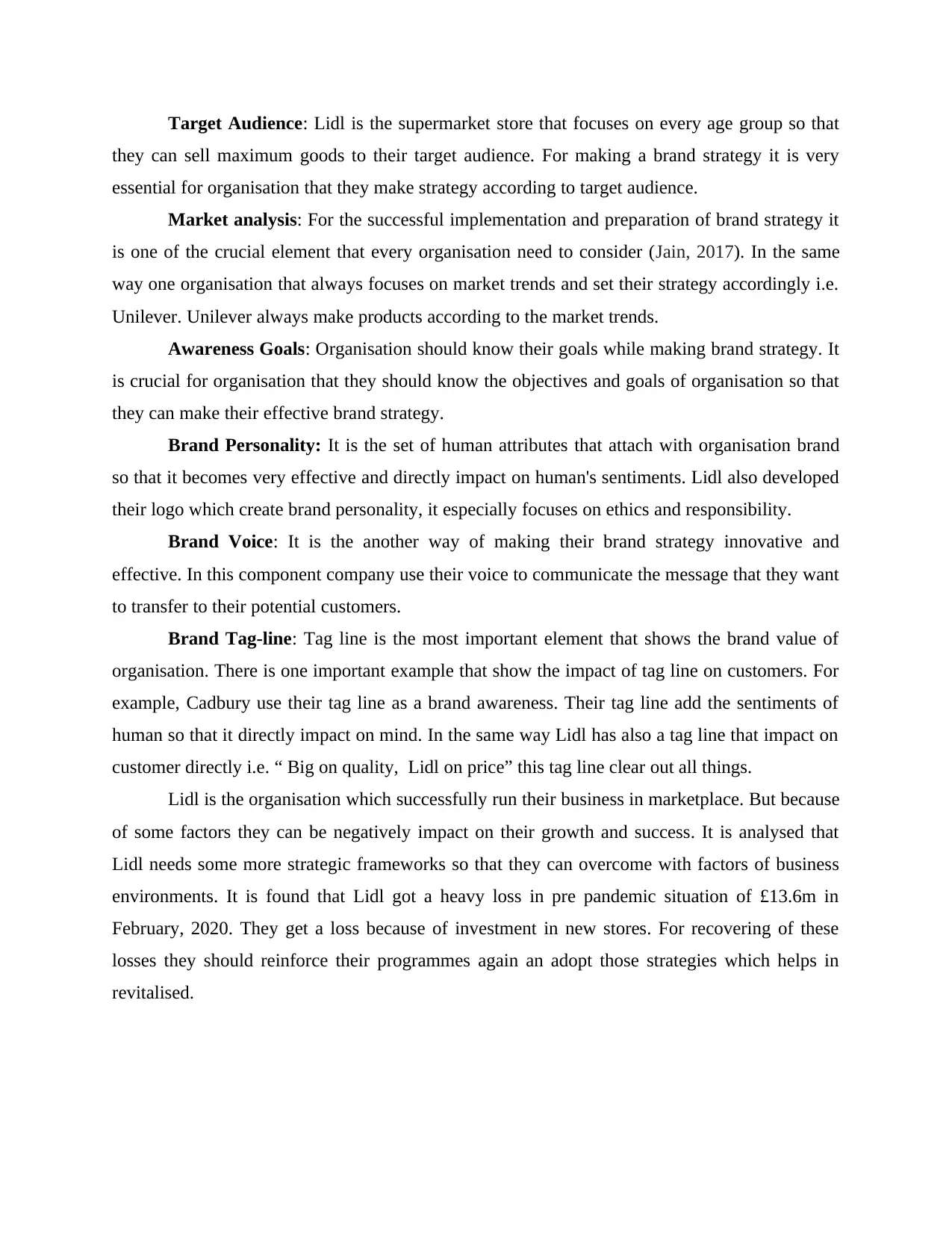
Target Audience: Lidl is the supermarket store that focuses on every age group so that
they can sell maximum goods to their target audience. For making a brand strategy it is very
essential for organisation that they make strategy according to target audience.
Market analysis: For the successful implementation and preparation of brand strategy it
is one of the crucial element that every organisation need to consider (Jain, 2017). In the same
way one organisation that always focuses on market trends and set their strategy accordingly i.e.
Unilever. Unilever always make products according to the market trends.
Awareness Goals: Organisation should know their goals while making brand strategy. It
is crucial for organisation that they should know the objectives and goals of organisation so that
they can make their effective brand strategy.
Brand Personality: It is the set of human attributes that attach with organisation brand
so that it becomes very effective and directly impact on human's sentiments. Lidl also developed
their logo which create brand personality, it especially focuses on ethics and responsibility.
Brand Voice: It is the another way of making their brand strategy innovative and
effective. In this component company use their voice to communicate the message that they want
to transfer to their potential customers.
Brand Tag-line: Tag line is the most important element that shows the brand value of
organisation. There is one important example that show the impact of tag line on customers. For
example, Cadbury use their tag line as a brand awareness. Their tag line add the sentiments of
human so that it directly impact on mind. In the same way Lidl has also a tag line that impact on
customer directly i.e. “ Big on quality, Lidl on price” this tag line clear out all things.
Lidl is the organisation which successfully run their business in marketplace. But because
of some factors they can be negatively impact on their growth and success. It is analysed that
Lidl needs some more strategic frameworks so that they can overcome with factors of business
environments. It is found that Lidl got a heavy loss in pre pandemic situation of £13.6m in
February, 2020. They get a loss because of investment in new stores. For recovering of these
losses they should reinforce their programmes again an adopt those strategies which helps in
revitalised.
they can sell maximum goods to their target audience. For making a brand strategy it is very
essential for organisation that they make strategy according to target audience.
Market analysis: For the successful implementation and preparation of brand strategy it
is one of the crucial element that every organisation need to consider (Jain, 2017). In the same
way one organisation that always focuses on market trends and set their strategy accordingly i.e.
Unilever. Unilever always make products according to the market trends.
Awareness Goals: Organisation should know their goals while making brand strategy. It
is crucial for organisation that they should know the objectives and goals of organisation so that
they can make their effective brand strategy.
Brand Personality: It is the set of human attributes that attach with organisation brand
so that it becomes very effective and directly impact on human's sentiments. Lidl also developed
their logo which create brand personality, it especially focuses on ethics and responsibility.
Brand Voice: It is the another way of making their brand strategy innovative and
effective. In this component company use their voice to communicate the message that they want
to transfer to their potential customers.
Brand Tag-line: Tag line is the most important element that shows the brand value of
organisation. There is one important example that show the impact of tag line on customers. For
example, Cadbury use their tag line as a brand awareness. Their tag line add the sentiments of
human so that it directly impact on mind. In the same way Lidl has also a tag line that impact on
customer directly i.e. “ Big on quality, Lidl on price” this tag line clear out all things.
Lidl is the organisation which successfully run their business in marketplace. But because
of some factors they can be negatively impact on their growth and success. It is analysed that
Lidl needs some more strategic frameworks so that they can overcome with factors of business
environments. It is found that Lidl got a heavy loss in pre pandemic situation of £13.6m in
February, 2020. They get a loss because of investment in new stores. For recovering of these
losses they should reinforce their programmes again an adopt those strategies which helps in
revitalised.
⊘ This is a preview!⊘
Do you want full access?
Subscribe today to unlock all pages.

Trusted by 1+ million students worldwide
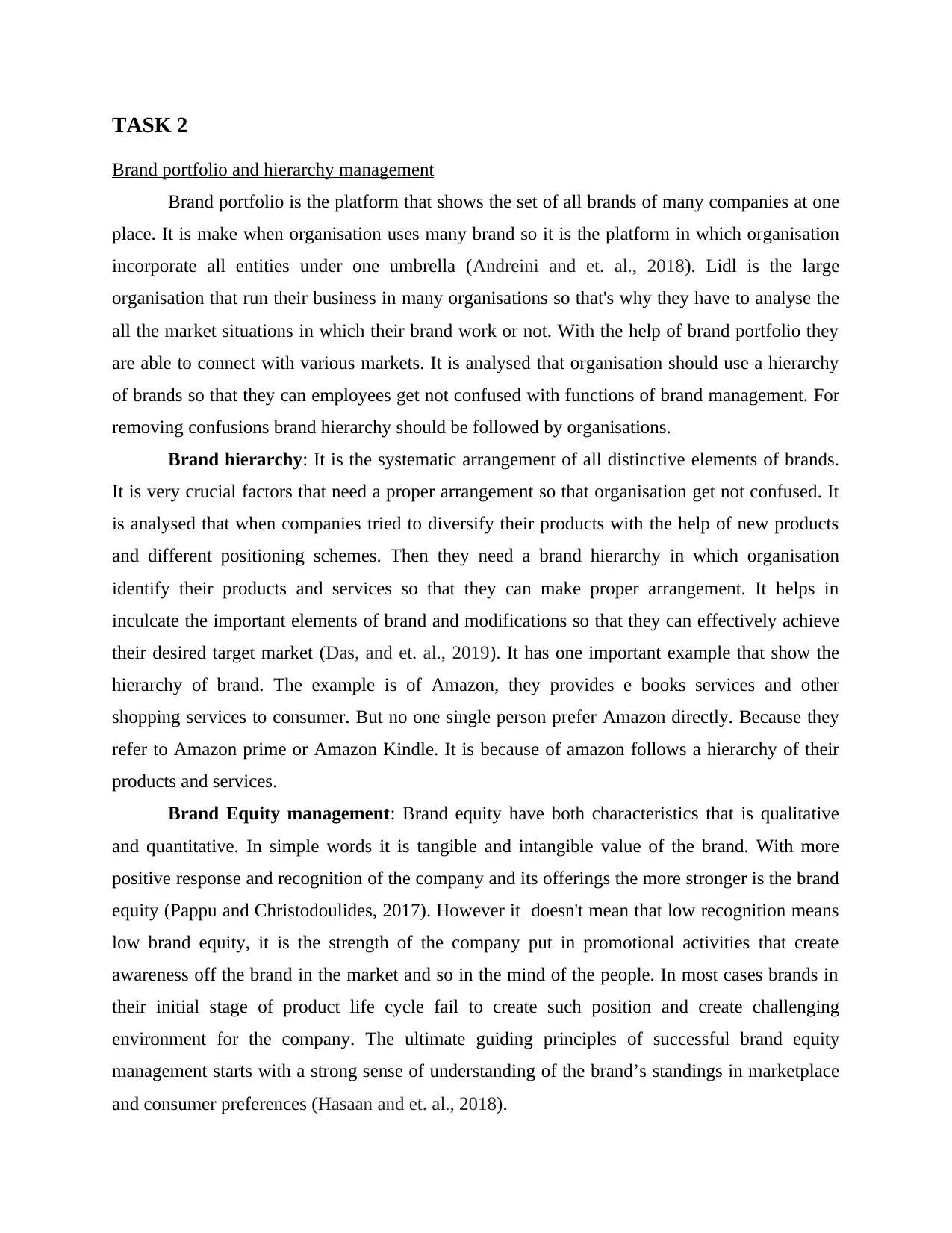
TASK 2
Brand portfolio and hierarchy management
Brand portfolio is the platform that shows the set of all brands of many companies at one
place. It is make when organisation uses many brand so it is the platform in which organisation
incorporate all entities under one umbrella (Andreini and et. al., 2018). Lidl is the large
organisation that run their business in many organisations so that's why they have to analyse the
all the market situations in which their brand work or not. With the help of brand portfolio they
are able to connect with various markets. It is analysed that organisation should use a hierarchy
of brands so that they can employees get not confused with functions of brand management. For
removing confusions brand hierarchy should be followed by organisations.
Brand hierarchy: It is the systematic arrangement of all distinctive elements of brands.
It is very crucial factors that need a proper arrangement so that organisation get not confused. It
is analysed that when companies tried to diversify their products with the help of new products
and different positioning schemes. Then they need a brand hierarchy in which organisation
identify their products and services so that they can make proper arrangement. It helps in
inculcate the important elements of brand and modifications so that they can effectively achieve
their desired target market (Das, and et. al., 2019). It has one important example that show the
hierarchy of brand. The example is of Amazon, they provides e books services and other
shopping services to consumer. But no one single person prefer Amazon directly. Because they
refer to Amazon prime or Amazon Kindle. It is because of amazon follows a hierarchy of their
products and services.
Brand Equity management: Brand equity have both characteristics that is qualitative
and quantitative. In simple words it is tangible and intangible value of the brand. With more
positive response and recognition of the company and its offerings the more stronger is the brand
equity (Pappu and Christodoulides, 2017). However it doesn't mean that low recognition means
low brand equity, it is the strength of the company put in promotional activities that create
awareness off the brand in the market and so in the mind of the people. In most cases brands in
their initial stage of product life cycle fail to create such position and create challenging
environment for the company. The ultimate guiding principles of successful brand equity
management starts with a strong sense of understanding of the brand’s standings in marketplace
and consumer preferences (Hasaan and et. al., 2018).
Brand portfolio and hierarchy management
Brand portfolio is the platform that shows the set of all brands of many companies at one
place. It is make when organisation uses many brand so it is the platform in which organisation
incorporate all entities under one umbrella (Andreini and et. al., 2018). Lidl is the large
organisation that run their business in many organisations so that's why they have to analyse the
all the market situations in which their brand work or not. With the help of brand portfolio they
are able to connect with various markets. It is analysed that organisation should use a hierarchy
of brands so that they can employees get not confused with functions of brand management. For
removing confusions brand hierarchy should be followed by organisations.
Brand hierarchy: It is the systematic arrangement of all distinctive elements of brands.
It is very crucial factors that need a proper arrangement so that organisation get not confused. It
is analysed that when companies tried to diversify their products with the help of new products
and different positioning schemes. Then they need a brand hierarchy in which organisation
identify their products and services so that they can make proper arrangement. It helps in
inculcate the important elements of brand and modifications so that they can effectively achieve
their desired target market (Das, and et. al., 2019). It has one important example that show the
hierarchy of brand. The example is of Amazon, they provides e books services and other
shopping services to consumer. But no one single person prefer Amazon directly. Because they
refer to Amazon prime or Amazon Kindle. It is because of amazon follows a hierarchy of their
products and services.
Brand Equity management: Brand equity have both characteristics that is qualitative
and quantitative. In simple words it is tangible and intangible value of the brand. With more
positive response and recognition of the company and its offerings the more stronger is the brand
equity (Pappu and Christodoulides, 2017). However it doesn't mean that low recognition means
low brand equity, it is the strength of the company put in promotional activities that create
awareness off the brand in the market and so in the mind of the people. In most cases brands in
their initial stage of product life cycle fail to create such position and create challenging
environment for the company. The ultimate guiding principles of successful brand equity
management starts with a strong sense of understanding of the brand’s standings in marketplace
and consumer preferences (Hasaan and et. al., 2018).
Paraphrase This Document
Need a fresh take? Get an instant paraphrase of this document with our AI Paraphraser
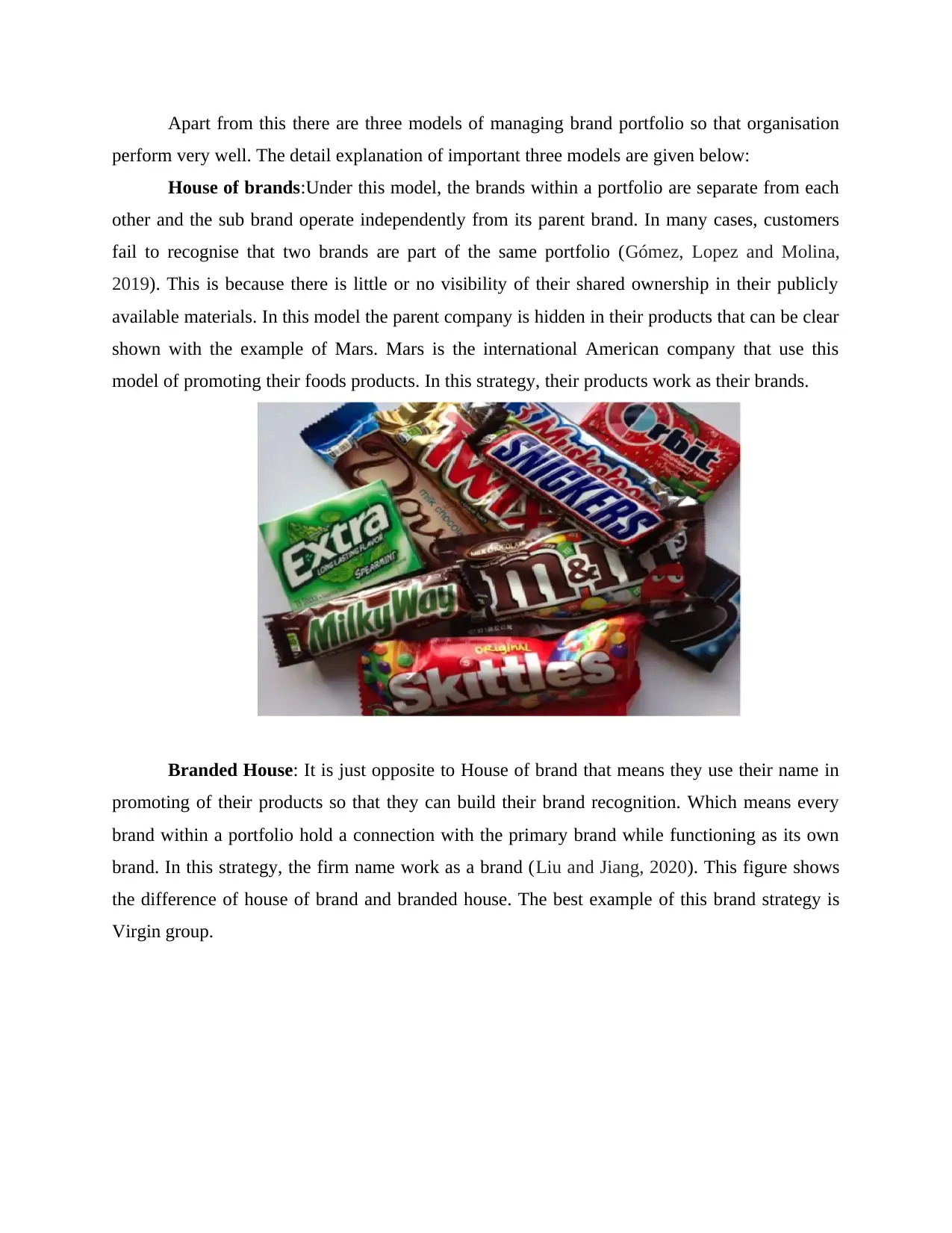
Apart from this there are three models of managing brand portfolio so that organisation
perform very well. The detail explanation of important three models are given below:
House of brands:Under this model, the brands within a portfolio are separate from each
other and the sub brand operate independently from its parent brand. In many cases, customers
fail to recognise that two brands are part of the same portfolio (Gómez, Lopez and Molina,
2019). This is because there is little or no visibility of their shared ownership in their publicly
available materials. In this model the parent company is hidden in their products that can be clear
shown with the example of Mars. Mars is the international American company that use this
model of promoting their foods products. In this strategy, their products work as their brands.
Branded House: It is just opposite to House of brand that means they use their name in
promoting of their products so that they can build their brand recognition. Which means every
brand within a portfolio hold a connection with the primary brand while functioning as its own
brand. In this strategy, the firm name work as a brand (Liu and Jiang, 2020). This figure shows
the difference of house of brand and branded house. The best example of this brand strategy is
Virgin group.
perform very well. The detail explanation of important three models are given below:
House of brands:Under this model, the brands within a portfolio are separate from each
other and the sub brand operate independently from its parent brand. In many cases, customers
fail to recognise that two brands are part of the same portfolio (Gómez, Lopez and Molina,
2019). This is because there is little or no visibility of their shared ownership in their publicly
available materials. In this model the parent company is hidden in their products that can be clear
shown with the example of Mars. Mars is the international American company that use this
model of promoting their foods products. In this strategy, their products work as their brands.
Branded House: It is just opposite to House of brand that means they use their name in
promoting of their products so that they can build their brand recognition. Which means every
brand within a portfolio hold a connection with the primary brand while functioning as its own
brand. In this strategy, the firm name work as a brand (Liu and Jiang, 2020). This figure shows
the difference of house of brand and branded house. The best example of this brand strategy is
Virgin group.
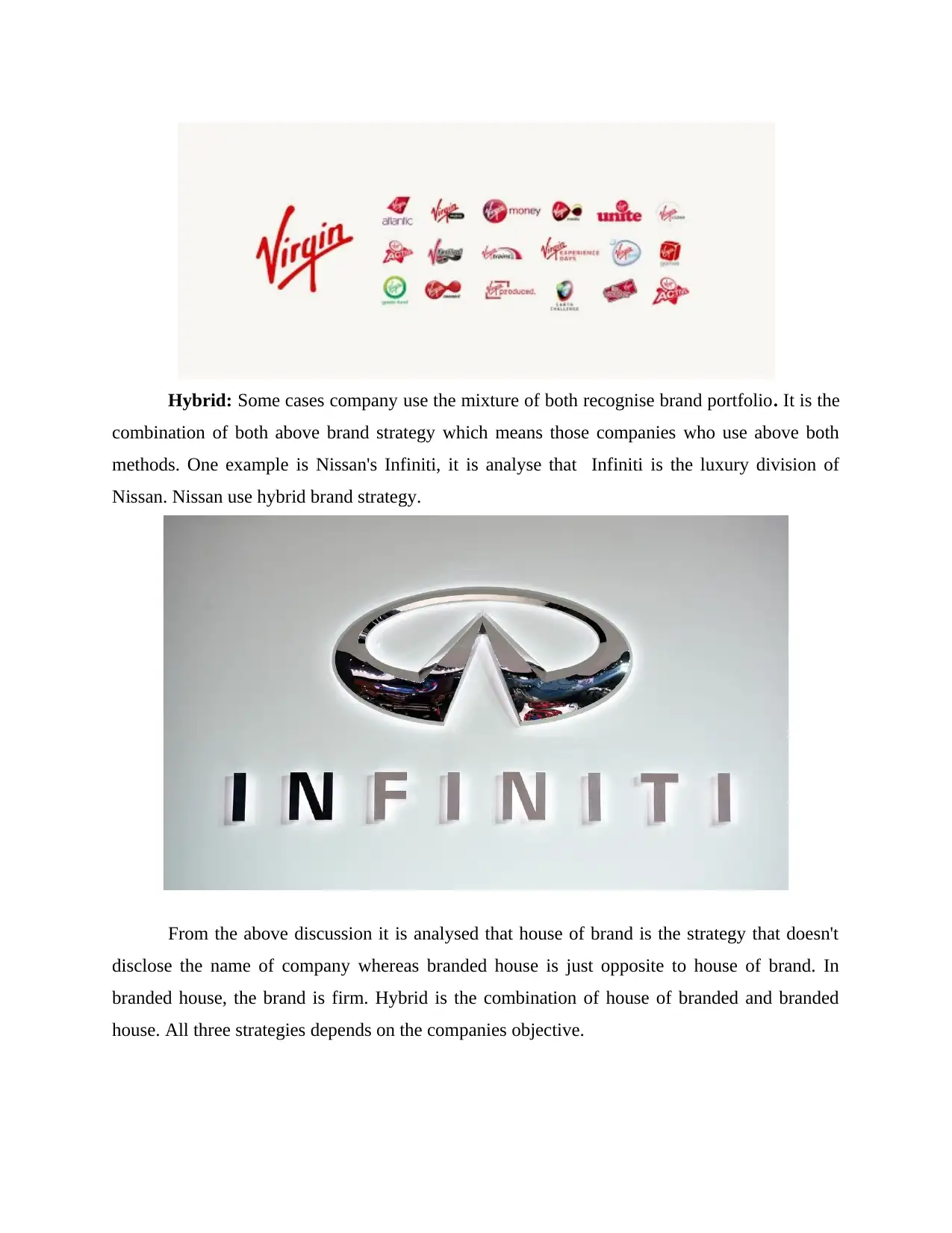
Hybrid: Some cases company use the mixture of both recognise brand portfolio. It is the
combination of both above brand strategy which means those companies who use above both
methods. One example is Nissan's Infiniti, it is analyse that Infiniti is the luxury division of
Nissan. Nissan use hybrid brand strategy.
From the above discussion it is analysed that house of brand is the strategy that doesn't
disclose the name of company whereas branded house is just opposite to house of brand. In
branded house, the brand is firm. Hybrid is the combination of house of branded and branded
house. All three strategies depends on the companies objective.
combination of both above brand strategy which means those companies who use above both
methods. One example is Nissan's Infiniti, it is analyse that Infiniti is the luxury division of
Nissan. Nissan use hybrid brand strategy.
From the above discussion it is analysed that house of brand is the strategy that doesn't
disclose the name of company whereas branded house is just opposite to house of brand. In
branded house, the brand is firm. Hybrid is the combination of house of branded and branded
house. All three strategies depends on the companies objective.
⊘ This is a preview!⊘
Do you want full access?
Subscribe today to unlock all pages.

Trusted by 1+ million students worldwide
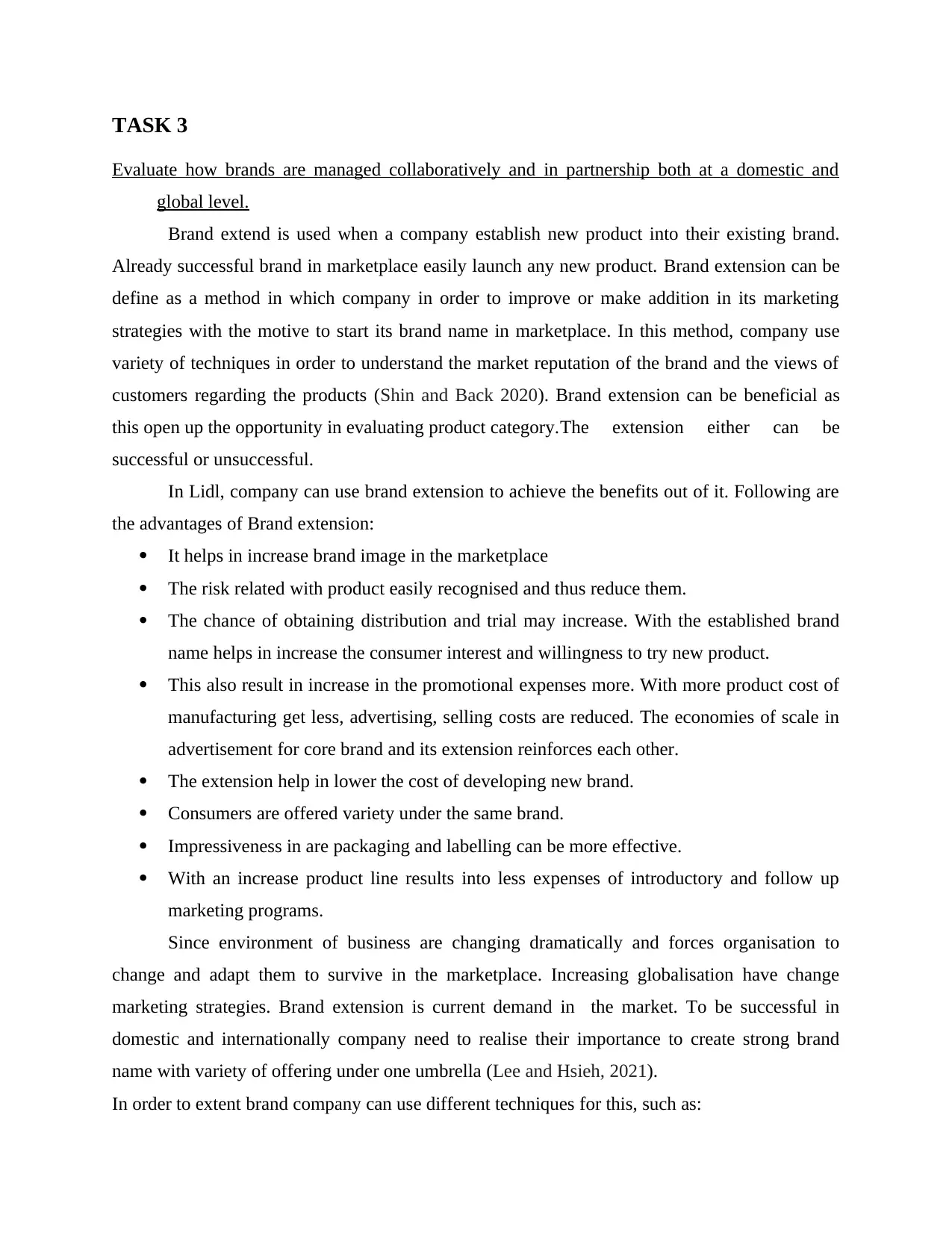
TASK 3
Evaluate how brands are managed collaboratively and in partnership both at a domestic and
global level.
Brand extend is used when a company establish new product into their existing brand.
Already successful brand in marketplace easily launch any new product. Brand extension can be
define as a method in which company in order to improve or make addition in its marketing
strategies with the motive to start its brand name in marketplace. In this method, company use
variety of techniques in order to understand the market reputation of the brand and the views of
customers regarding the products (Shin and Back 2020). Brand extension can be beneficial as
this open up the opportunity in evaluating product category.The extension either can be
successful or unsuccessful.
In Lidl, company can use brand extension to achieve the benefits out of it. Following are
the advantages of Brand extension:
It helps in increase brand image in the marketplace
The risk related with product easily recognised and thus reduce them.
The chance of obtaining distribution and trial may increase. With the established brand
name helps in increase the consumer interest and willingness to try new product.
This also result in increase in the promotional expenses more. With more product cost of
manufacturing get less, advertising, selling costs are reduced. The economies of scale in
advertisement for core brand and its extension reinforces each other.
The extension help in lower the cost of developing new brand.
Consumers are offered variety under the same brand.
Impressiveness in are packaging and labelling can be more effective.
With an increase product line results into less expenses of introductory and follow up
marketing programs.
Since environment of business are changing dramatically and forces organisation to
change and adapt them to survive in the marketplace. Increasing globalisation have change
marketing strategies. Brand extension is current demand in the market. To be successful in
domestic and internationally company need to realise their importance to create strong brand
name with variety of offering under one umbrella (Lee and Hsieh, 2021).
In order to extent brand company can use different techniques for this, such as:
Evaluate how brands are managed collaboratively and in partnership both at a domestic and
global level.
Brand extend is used when a company establish new product into their existing brand.
Already successful brand in marketplace easily launch any new product. Brand extension can be
define as a method in which company in order to improve or make addition in its marketing
strategies with the motive to start its brand name in marketplace. In this method, company use
variety of techniques in order to understand the market reputation of the brand and the views of
customers regarding the products (Shin and Back 2020). Brand extension can be beneficial as
this open up the opportunity in evaluating product category.The extension either can be
successful or unsuccessful.
In Lidl, company can use brand extension to achieve the benefits out of it. Following are
the advantages of Brand extension:
It helps in increase brand image in the marketplace
The risk related with product easily recognised and thus reduce them.
The chance of obtaining distribution and trial may increase. With the established brand
name helps in increase the consumer interest and willingness to try new product.
This also result in increase in the promotional expenses more. With more product cost of
manufacturing get less, advertising, selling costs are reduced. The economies of scale in
advertisement for core brand and its extension reinforces each other.
The extension help in lower the cost of developing new brand.
Consumers are offered variety under the same brand.
Impressiveness in are packaging and labelling can be more effective.
With an increase product line results into less expenses of introductory and follow up
marketing programs.
Since environment of business are changing dramatically and forces organisation to
change and adapt them to survive in the marketplace. Increasing globalisation have change
marketing strategies. Brand extension is current demand in the market. To be successful in
domestic and internationally company need to realise their importance to create strong brand
name with variety of offering under one umbrella (Lee and Hsieh, 2021).
In order to extent brand company can use different techniques for this, such as:
Paraphrase This Document
Need a fresh take? Get an instant paraphrase of this document with our AI Paraphraser
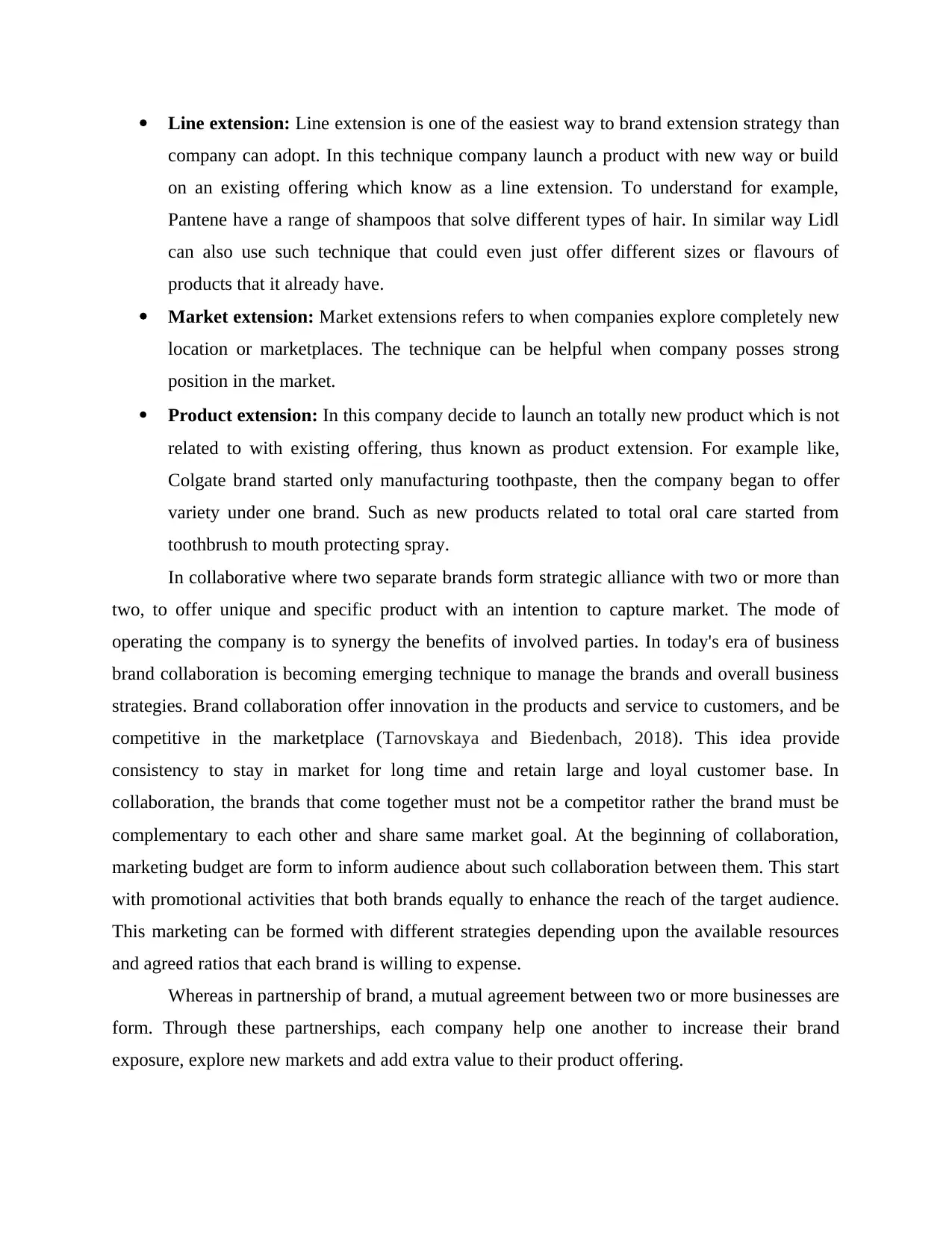
Line extension: Line extension is one of the easiest way to brand extension strategy than
company can adopt. In this technique company launch a product with new way or build
on an existing offering which know as a line extension. To understand for example,
Pantene have a range of shampoos that solve different types of hair. In similar way Lidl
can also use such technique that could even just offer different sizes or flavours of
products that it already have.
Market extension: Market extensions refers to when companies explore completely new
location or marketplaces. The technique can be helpful when company posses strong
position in the market.
Product extension: In this company decide to launch an totally new product which is not
related to with existing offering, thus known as product extension. For example like,
Colgate brand started only manufacturing toothpaste, then the company began to offer
variety under one brand. Such as new products related to total oral care started from
toothbrush to mouth protecting spray.
In collaborative where two separate brands form strategic alliance with two or more than
two, to offer unique and specific product with an intention to capture market. The mode of
operating the company is to synergy the benefits of involved parties. In today's era of business
brand collaboration is becoming emerging technique to manage the brands and overall business
strategies. Brand collaboration offer innovation in the products and service to customers, and be
competitive in the marketplace (Tarnovskaya and Biedenbach, 2018). This idea provide
consistency to stay in market for long time and retain large and loyal customer base. In
collaboration, the brands that come together must not be a competitor rather the brand must be
complementary to each other and share same market goal. At the beginning of collaboration,
marketing budget are form to inform audience about such collaboration between them. This start
with promotional activities that both brands equally to enhance the reach of the target audience.
This marketing can be formed with different strategies depending upon the available resources
and agreed ratios that each brand is willing to expense.
Whereas in partnership of brand, a mutual agreement between two or more businesses are
form. Through these partnerships, each company help one another to increase their brand
exposure, explore new markets and add extra value to their product offering.
company can adopt. In this technique company launch a product with new way or build
on an existing offering which know as a line extension. To understand for example,
Pantene have a range of shampoos that solve different types of hair. In similar way Lidl
can also use such technique that could even just offer different sizes or flavours of
products that it already have.
Market extension: Market extensions refers to when companies explore completely new
location or marketplaces. The technique can be helpful when company posses strong
position in the market.
Product extension: In this company decide to launch an totally new product which is not
related to with existing offering, thus known as product extension. For example like,
Colgate brand started only manufacturing toothpaste, then the company began to offer
variety under one brand. Such as new products related to total oral care started from
toothbrush to mouth protecting spray.
In collaborative where two separate brands form strategic alliance with two or more than
two, to offer unique and specific product with an intention to capture market. The mode of
operating the company is to synergy the benefits of involved parties. In today's era of business
brand collaboration is becoming emerging technique to manage the brands and overall business
strategies. Brand collaboration offer innovation in the products and service to customers, and be
competitive in the marketplace (Tarnovskaya and Biedenbach, 2018). This idea provide
consistency to stay in market for long time and retain large and loyal customer base. In
collaboration, the brands that come together must not be a competitor rather the brand must be
complementary to each other and share same market goal. At the beginning of collaboration,
marketing budget are form to inform audience about such collaboration between them. This start
with promotional activities that both brands equally to enhance the reach of the target audience.
This marketing can be formed with different strategies depending upon the available resources
and agreed ratios that each brand is willing to expense.
Whereas in partnership of brand, a mutual agreement between two or more businesses are
form. Through these partnerships, each company help one another to increase their brand
exposure, explore new markets and add extra value to their product offering.
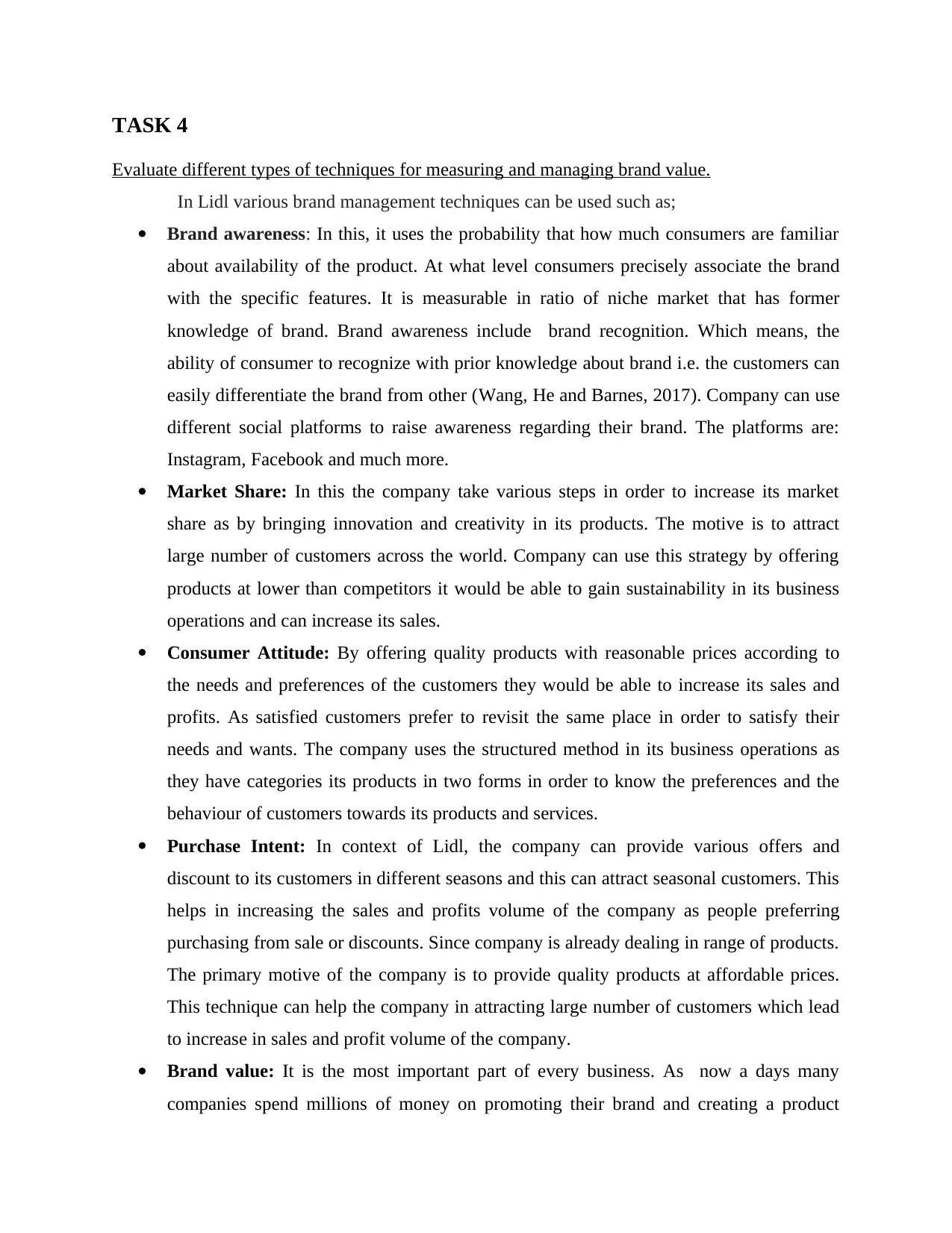
TASK 4
Evaluate different types of techniques for measuring and managing brand value.
In Lidl various brand management techniques can be used such as;
Brand awareness: In this, it uses the probability that how much consumers are familiar
about availability of the product. At what level consumers precisely associate the brand
with the specific features. It is measurable in ratio of niche market that has former
knowledge of brand. Brand awareness include brand recognition. Which means, the
ability of consumer to recognize with prior knowledge about brand i.e. the customers can
easily differentiate the brand from other (Wang, He and Barnes, 2017). Company can use
different social platforms to raise awareness regarding their brand. The platforms are:
Instagram, Facebook and much more.
Market Share: In this the company take various steps in order to increase its market
share as by bringing innovation and creativity in its products. The motive is to attract
large number of customers across the world. Company can use this strategy by offering
products at lower than competitors it would be able to gain sustainability in its business
operations and can increase its sales.
Consumer Attitude: By offering quality products with reasonable prices according to
the needs and preferences of the customers they would be able to increase its sales and
profits. As satisfied customers prefer to revisit the same place in order to satisfy their
needs and wants. The company uses the structured method in its business operations as
they have categories its products in two forms in order to know the preferences and the
behaviour of customers towards its products and services.
Purchase Intent: In context of Lidl, the company can provide various offers and
discount to its customers in different seasons and this can attract seasonal customers. This
helps in increasing the sales and profits volume of the company as people preferring
purchasing from sale or discounts. Since company is already dealing in range of products.
The primary motive of the company is to provide quality products at affordable prices.
This technique can help the company in attracting large number of customers which lead
to increase in sales and profit volume of the company.
Brand value: It is the most important part of every business. As now a days many
companies spend millions of money on promoting their brand and creating a product
Evaluate different types of techniques for measuring and managing brand value.
In Lidl various brand management techniques can be used such as;
Brand awareness: In this, it uses the probability that how much consumers are familiar
about availability of the product. At what level consumers precisely associate the brand
with the specific features. It is measurable in ratio of niche market that has former
knowledge of brand. Brand awareness include brand recognition. Which means, the
ability of consumer to recognize with prior knowledge about brand i.e. the customers can
easily differentiate the brand from other (Wang, He and Barnes, 2017). Company can use
different social platforms to raise awareness regarding their brand. The platforms are:
Instagram, Facebook and much more.
Market Share: In this the company take various steps in order to increase its market
share as by bringing innovation and creativity in its products. The motive is to attract
large number of customers across the world. Company can use this strategy by offering
products at lower than competitors it would be able to gain sustainability in its business
operations and can increase its sales.
Consumer Attitude: By offering quality products with reasonable prices according to
the needs and preferences of the customers they would be able to increase its sales and
profits. As satisfied customers prefer to revisit the same place in order to satisfy their
needs and wants. The company uses the structured method in its business operations as
they have categories its products in two forms in order to know the preferences and the
behaviour of customers towards its products and services.
Purchase Intent: In context of Lidl, the company can provide various offers and
discount to its customers in different seasons and this can attract seasonal customers. This
helps in increasing the sales and profits volume of the company as people preferring
purchasing from sale or discounts. Since company is already dealing in range of products.
The primary motive of the company is to provide quality products at affordable prices.
This technique can help the company in attracting large number of customers which lead
to increase in sales and profit volume of the company.
Brand value: It is the most important part of every business. As now a days many
companies spend millions of money on promoting their brand and creating a product
⊘ This is a preview!⊘
Do you want full access?
Subscribe today to unlock all pages.

Trusted by 1+ million students worldwide
1 out of 15
Related Documents
Your All-in-One AI-Powered Toolkit for Academic Success.
+13062052269
info@desklib.com
Available 24*7 on WhatsApp / Email
![[object Object]](/_next/static/media/star-bottom.7253800d.svg)
Unlock your academic potential
Copyright © 2020–2025 A2Z Services. All Rights Reserved. Developed and managed by ZUCOL.





